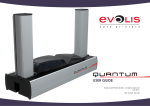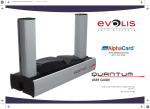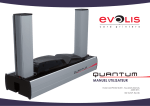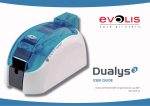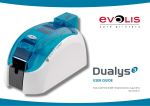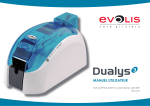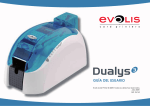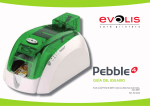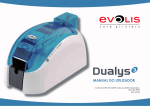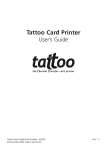Download Evolis RVA022NAA printer ribbon
Transcript
Advanced consumables for quality printing SECURED CARDS V 1.1 – SEPTEMBER 2011 TABLE OF CONTENTS 1. Introduction 3 2. The lamination 3 What is the lamination? 3 Why use the lamination? 3 Type of films 4 Type of cards 4 To help you in your choice 4 3. The hologram on cards 6 What is a hologram? 6 Why use a hologram as a security feature? 6 Holographic Evolis designs 7 Evolis Custom hologram solution 8 To help you in your choice 12 © 2011 Evolis Card Printer. The content of this document is for informational use only. It is subject to change without notice and should not be considered as a commitment by Evolis Card Printer. Evolis Card Printer assumes no responsibility or liability for any errors or inaccuracies that may appear in this documentation. No part of this publication may be reproduced, stored in a retrieval system, or transmitted, in any form or by any means, electronic, mechanical, recording or otherwise, without the prior written permission of Evolis Card Printer. Evolis Card Printer - 14, avenue de la Fontaine - Z.I. Angers Beaucouzé - F-49070 BEAUCOUZE 1. INTRODUCTION For official document such as National ID cards, driving licenses, or to reinforce the security of your business or organization, a simple ID badge is not enough. In a way to protect your interests and your identity, the setting up of a secured identification can be necessary. Each secured identity solution is unique and involve a number of question to ask before full implementation, for example: Lifespan and card resistance Level of security: a simple secured identification with impossible to forge but visible elements or a high secured level with hidden or invisible for human eye elements? Conception: protection of the front card only or of the both sides? The kind of information to include on cards. - 2. THE LAMINATION What is the lamination The lamination consists in the reinforcement of the card surface, applying a patch or a film to protect the card from wear and tear and UV rays and to fight forgery. In general, this action is performed in two steps by the machine: first it prints and then applies a film. The varnish or film is applied at a very high temperature is out of reach of a traditional print heads, and therefore, requires special equipment: a laminator. Why use the lamination ? Laminators feature hot rollers that provide temperatures in the 280-375°F (140-190°C) range. With such temperatures, laminators actually “stick” the lamination material onto the plastic card. This technology can be used when: The cards are used frequently in readers for barcodes, magnetic stripes or smart cards. More than three years lifespan Cards require a high level of security and must be impossible to forge. © 2011 Evolis Card Printer. All rights reserved. Evolis reserves the right to make changes at any time without notice. All other names and trademarks are the property of their respective owners. September 2011. 3 Protective layer (lamination film) Printed data (picture and text) RFID chip Example of card with lamination patch: A patch or a film can have different thicknesses depending of the protection you want for your cards. If you choose to apply a film instead of a patch, it will cover the whole card’s surface. Type of films Patches: these are thick films aiming at protecting a card from 3 to 10 years, depending on patch thickness 0.6 mil (15 microns) or 1.0 mil (25 microns). They are recommended for applications requiring high durability and high tamper resistance. The patches do not cover the entire card surface. Varnishes: the ribbons apply a thin layer (about 4 microns) to the cards, edge-to-edge. They will protect the cards for 2 to 3 years and are recommended for applications requiring a low durability and a minimal tamper resistance. The film, similar to a monochrome ribbon, is continuous and does not require adjustment or positioning. The Evolis Lamination ribbons are specially designed for: Extreme durability and protection from water and humidity for identification cards. Excellent adhesion to card surfaces Excellent clarity Type of films Any regular PVC card can be used to apply a varnish since it will be transferred at a quite low temperature. The bending effect will be very smooth. When applying patches it is recommended to use composite cards made with PET and PVC. Depending on the patch thickness (0.6 mil), it is also possible to laminate on regular PVC material with a very limited bending. © 2011 Evolis Card Printer. All rights reserved. Evolis reserves the right to make changes at any time without notice. All other names and trademarks are the property of their respective owners. September 2011. 4 To help you in your choice First of all, you have to take account the lifespan and the card resistance. Is a varnish enough? Do you need a superior card resistance? High durability According to the type of material you choose, your cards will be more durable. Varnishes and patches 0.6 mil Estimated lifespan: - Topcoat: 2 to 3 years - Varnishes and patches 0.6 mil thick: until 5 years. - Patches 1.0 mil: up to 10 years. Patches 1.0 mil Topcoat Normal durability These films can be translucent (protection against UV radiation as standard) or with holograms. Our lamination patches can be standard, with identical patches on the ribbon, or alternated (for dual-sided lamination). Multiple design layouts can be combined to match different requirements: Application on the full surface of the card Layout for cards that have a magnetic stripe Layout for contact smart card © 2011 Evolis Card Printer. All rights reserved. Evolis reserves the right to make changes at any time without notice. All other names and trademarks are the property of their respective owners. September 2011. 5 3. THE HOLOGRAMS ON CARDS What is a hologram? A hologram is a three-dimensional image, created with photographic projection. Unlike 3D or virtual reality on a two-dimensional computer display, a hologram is a truly three-dimensional and free-standing image that does not simulate spatial depth or require a special viewing device. To reproduce the image of an object, the hologram is illuminated by coherent light, ideally the original reference beam. The hologram produces two sets of diffracted waves; one set forms a virtual image coinciding with the original object position and the other set forms a real image on the other side of the plate. Both are three-dimensional. A hologram is an optical device which produces an image: Which exhibits variable colours (rainbow) With variable image content Which can be animated Which appears as stereoscopic. Why use a hologram as a security feature? The hologram is a security enforcement tool because it is not possible to duplicate a hologram with a scanner or a color photocopying machine and it is not possible to manufacture or copy a hologram through standard printing processes. The initial level of visual security can be used to integrate additional levels of control for a card. Creation and reproduction of holograms are exclusively performed by a small number of industrial companies. The techniques employed are complex and use very rigorous procedures. Holograms, therefore, stand as a dependable solution for printing secured badges and cards. No material is required to control the genuineness of a hologram. This can quickly and reliably be performed at a glance. A hologram is applied on the card in the form of a transparent layer, thanks to a special ribbon. The ribbons proposed by EVOLIS are totally transparent ribbons comprising holographic and optical images. The optical images of the ribbons are shinny, very high definition, 3D animated and with very high resistance against counterfeiting. Ribbons are used to seal the information contained on the plastic cards. The information is therefore authenticated and protected from falsification or substitution © 2011 Evolis Card Printer. All rights reserved. Evolis reserves the right to make changes at any time without notice. All other names and trademarks are the property of their respective owners. September 2011. 6 Holographic Evolis design There are two ways to apply holograms with Evolis printers. First, you can use a printer equipped with a laminator station, such as Securion. Thank to this printer you could apply varnish films or patches, thicker than an overlay, allowing a better lifespan of your cards. - Hologram for Lamination: This design is available as patch or as varnish. The second way to apply a hologram is to use a dye-diffusion thermal transfer. With the Evolis Pebble4 and Dualys3, you can apply varnish films with hologram. © 2011 Evolis Card Printer. All rights reserved. Evolis reserves the right to make changes at any time without notice. All other names and trademarks are the property of their respective owners. September 2011. 7 - Hologram for Thermal Transfer: These two card personalization systems provide flexibility and enable to obtain within a few minutes a finished card-in-hand with hologram. Evolis Custom Hologram Solution Adding security to your badge may require a custom hologram film. Managed as a special project at Evolis, this film will be designed according to your company requirements. Customized hologram will help you to reach a significant security level thanks to its unique and registered design. Custom hologram for plastic cards must meet two fundamental requirements: Protect the data against falsification Protect the data against abrasion and other physical and chemical aggressions A card protected with a Hologram ribbon will be very resistant. Any attempt of falsification will therefore become very obvious and visible. © 2011 Evolis Card Printer. All rights reserved. Evolis reserves the right to make changes at any time without notice. All other names and trademarks are the property of their respective owners. September 2011. 8 - The security levels : LEVEL 1 When the secured document will be viewed by the public LEVEL 2 When the secured document will be subject to inspection LEVEL 3 When the secured document is subject to forensic examination This hologram has features that are visible and discernible to the average person who has no training or instruction. The images, lines or text are immediately obvious to the viewer. Supports OVERT features This hologram includes features that are not immediately discernible to the average person. These elements are only discernible when an examiner utilizes an additional tool and possesses some level of training. The tools used to expose the feature are simple items such as a magnifying glass, flashlight, or laser pen. Supports OVERT – COVERT features This hologram includes features that are visible or discernible only with complex laboratory equipment. Persons investigating these features require more extensive training. Supports OVERT – COVERT – FORENSIC features - LEVEL 4 When the risk of counterfeiting is extreme This hologram includes features that are technically unique and often have only one source of production. These sources produce a variety of unique optical technologies that do not rely solely on the holographic process. Supports OVERT – COVERT – FORENSIC – UNIQUE features The security features: Example of a personalized secure card: © 2011 Evolis Card Printer. All rights reserved. Evolis reserves the right to make changes at any time without notice. All other names and trademarks are the property of their respective owners. September 2011. 9 Explanation of the features used: 1. Single Axis CLR (Covert Laser Retrievable) – 7. Rainbow Coloring – Images, lines or characters that Images or characters that are undecipherable to refract light using the full color spectrum. The color the human eye. They are decoded by illuminating changes as viewing angle changes. the coded area with a laser device and looking for (Level 1 - Overt) the refracted light projected back at a specific angle. (Level 2 – Covert) 2. Halftone Dither Effect - Propriety banknote 8. 2D3D or Multiple Plane Effect – Images, lines or software is used to create unique effects which characters that are composed of elements on the surface cannot be created with standard laser origination plane, above the surface plane or in the background. methods. Same software used for item 3 Line Elements above the surface plane or in the background Width Modulation. exhibit a sense of depth and parallax. (Level 2 – Overt/Covert) (Level 1 - Overt) 3. Line Width Modulation (LWM) – Various image 9. and text effects that can be created by the shapes that morph color as they are rotated. mathematical manipulation of width, length and (Level 1 - Overt) Animated Geometrical Shapes Morph- Geometric height of lines. (Level 3 – Overt/ Forensic / Level 4 - Unique) 4. Guilloche Patterns – A series of high resolution 10. Multiple Channel (Switch) Effect – Two or more distinct lines, curves and rosettes or any combination of images that occupy the same area of the hologram. These these elements. These designs are generated by images shift from one to the other when viewed from using very sophisticated software. Each element different angles. can be assigned a predetermined color shift to (Level 1 - Overt) create an illusion of synchronized animation. (Level 1 - Overt) 5. or 11. Nano Text - Diffractive or non Diffractive text that photographs that are reduced in size to as little as Micro Imagery – True color images ranges in size from 175 to 40 microns. The text can be three square millimeters. clearly seen only through a microscope. (Level 3 - Forensic) (Level 3 - Forensic) 6. Embossed Effect – Optical illusion of relief created by a highly diffractive surface oriented grating that can be applied to images, text or lines in a hologram. (Level 1 - Overt) © 2011 Evolis Card Printer. All rights reserved. Evolis reserves the right to make changes at any time without notice. All other names and trademarks are the property of their respective owners. September 2011. 10 The following board shows you the other security features proposed by Evolis. Gray Scale Coloring – Images, lines or characters that Dual Axis CLR (Covert Laser Retrievable) – have no color refraction, but are composed of black, Images or characters that are undecipherable to white or neutral variations of gray. the human eye. They are decoded by illuminating (Level 1 - Overt) the coded area with a laser device and looking at the refracted light projected back at a specific angle. Dual Axis CLRs have more than one set of images or characters that are viewed at ninety degree angles from each other. (Level 2 – Covert) True Coloring – Images that refract their true colors only Micro Text – Is diffractive or non diffractive text, when viewed at a very specific angle. whose size can be as small as 175 microns. And (Level 1 - Overt) can be clearly viewed only with an eye loop or a magnifying glass. (Level 2 - Covert) Stereogram – An optical illusion of depth and movement Font Specific Text- Lines made from random fonts created from one or more flat, two-dimensional images. or words that look like ordinary lines until (Level 1 - Overt) magnified to reveal the true object. (Level 2 - Covert) Wireframe Text- Outline of words and objects that can Holographic Watermark – A translucent relief of an be combined with other effects to make a more complex image or text that causes some part of the image image. or test to appear convex. (Level 1 – Overt) (Level 2 - Covert) Latent Effect – Images, lines or characters that are Hybrid Micro Optical Structures – The intentional designed to refract light at a very severe angle. The manipulation of the optical structures that compose hologram has to be rotated ninety degrees in order to the hologram in a predefined, undisclosed area to see the feature. create a unique fingerprint. (Level 3 – Forensic) (Level 2 - Covert) Combined Effects – In some instances two or more Floating Image: A unique covert feature whereby a effect can be combined on the same area or feature of a pair of images are projected and appear to float hologram in order to create a unique hard to duplicate above heterogeneous effect. For example, LWM and Micro illuminated with a standard flash light. Available in Text can be combined to create a very unique feature. 2012. (Level 3 – Forensic/Level 4- Unique) the surface of the hologram (Level 1 to Level 3) All these features can be applied on all types of films proposed by Evolis (varnishes or patches). For further information on this specific product, please refer to the “Evolis Custom Hologram guide” © 2011 Evolis Card Printer. All rights reserved. Evolis reserves the right to make changes at any time without notice. All other names and trademarks are the property of their respective owners. September 2011. 11 when To help you in your choice High Security Custom Hologram Generic Holographic Overlay Generic Holographic Patch Low security According to the type of material you choose, your cards will be more durable and secured. Estimated lifespan and security level: - Generic Holographic Overlay: Intermediate security level. - Generic Holographic Patch: High security level. - Custom Hologram: Maximum security level. Evolis proposes a large range of solutions to provide you different levels of durability and security for your printing. © 2011 Evolis Card Printer. All rights reserved. Evolis reserves the right to make changes at any time without notice. All other names and trademarks are the property of their respective owners. September 2011. 12












